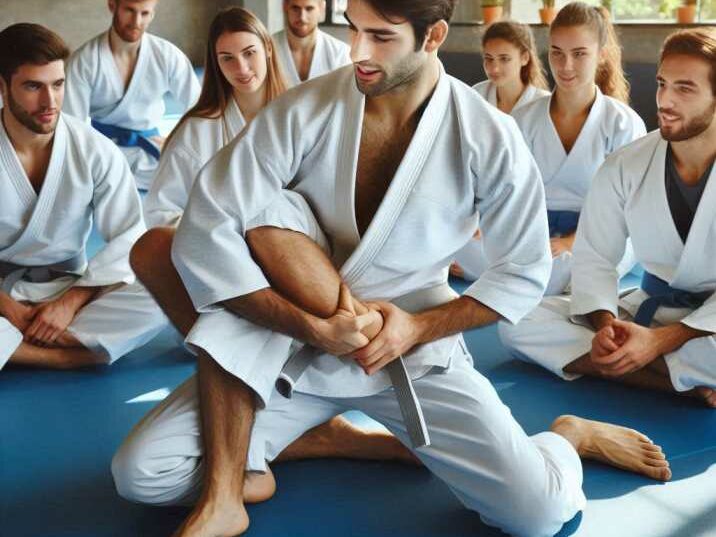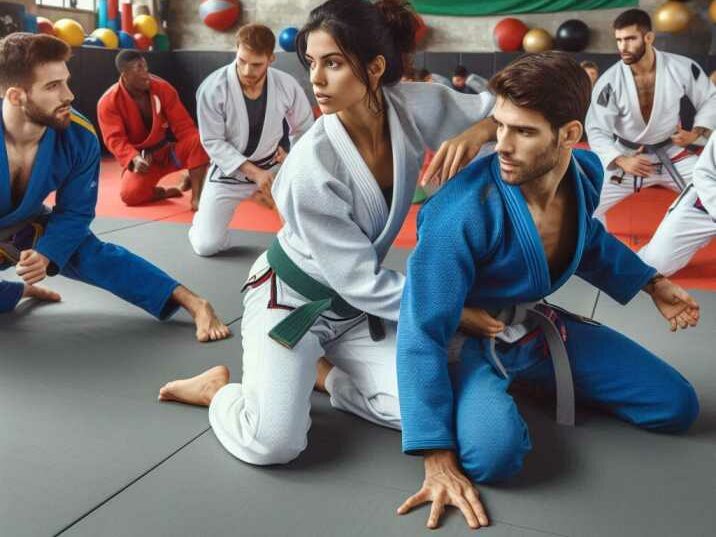Introduction
Table of Contents
Imagine being in a high-stakes martial arts match, your opponent closing in with swift, calculated moves. As they seem to have the upper hand, you use a grappling technique to turn the tide. This isn’t just a fantasy—it’s the essence of grappling in martial arts. Grappling, a critical element in various martial arts disciplines, offers a blend of strategy, skill, and physical prowess.
In this blog post, we’ll explore what grappling in martial arts is, its importance, and how you can master it. Whether you’re a beginner looking to understand the basics or an experienced martial artist aiming to refine your skills, this comprehensive guide is for you. We’ll cover different grappling techniques, their benefits, and how they can be applied in real-life scenarios.
What is Grappling?
Grappling involves techniques that focus on gaining a physical advantage over an opponent using grabs, holds, and leverage. Unlike striking arts, which rely on punches and kicks, grappling is about controlling your opponent through close contact.
Grappling techniques are not limited to one martial art. They are found in Brazilian Jiu-Jitsu (BJJ), Judo, Wrestling, and Mixed Martial Arts (MMA). The objective is often to submit the opponent by pinning them or applying a joint lock or choke.

The History of Grappling in Martial Arts
The history of grappling in martial arts dates back to ancient civilizations. Early forms of grappling can be traced to Egyptian and Greek wrestling styles. These techniques were used both in combat and sport, evolving over time into the various martial arts disciplines we know today.
In ancient Japan, grappling techniques were integral to Samurai warriors. Over time, these techniques evolved into Judo and Jiu-Jitsu. Similarly, in India, grappling has been a part of traditional martial arts like Pehlwani for centuries.
Types of Grappling Techniques
Joint Locks
Joint locks involve manipulating an opponent’s joints in ways that cause pain or risk of injury, compelling them to submit. Standard joint locks target the arms, wrists, and ankles.
Chokes and Strangles
These techniques obstruct the airway or blood flow to the brain, causing the opponent to submit or lose consciousness. The rear-naked choke and guillotine choke are famous examples.
Takedowns and Throws
Takedowns and throws aim to bring the opponent to the ground, often gaining dominance. Techniques like the double-leg takedown in wrestling or the hip throw in Judo are classic examples.
Pins and Holds
Pins and holds are used to control an opponent on the ground. The key is maintaining a superior position, such as the mount or side control, making it difficult for the opponent to escape.
The Role of Grappling in Modern Martial Arts
Grappling has become a staple in modern martial arts, especially in MMA. Fighters like Khabib Nurmagomedov have showcased the effectiveness of grappling, dominating opponents with superior ground control.
In BJJ, grappling is the core focus. Practitioners spend years refining their techniques, turning grappling into a highly technical and strategic art form. Similarly, Judo emphasizes throws and ground control, making it another grappling-centric martial art.
Why Grappling is Essential for Self-Defense
Grappling in martial arts isn’t just for sport; it’s also a crucial element of self-defense. In real-life scenarios, fights often end up in close quarters. Knowing how to grapple can give you a significant advantage, allowing you to control the situation effectively.
Techniques like joint locks and chokes can neutralize an attacker without requiring brute force. This makes grappling an invaluable skill for anyone interested in self-defense.
Benefits of Learning Grappling
Physical Fitness
Grappling is a full-body workout that improves strength, endurance, and flexibility. It engages multiple muscle groups, offering a comprehensive fitness regimen.
Mental Toughness
Grappling requires strategic thinking and mental resilience. Practitioners learn to stay calm under pressure, think several moves ahead, and adapt to their opponent’s actions.
Confidence
Mastering grappling techniques boosts self-confidence. Knowing you can handle yourself in a physical confrontation provides a sense of security and self-assurance.
Getting Started with Grappling
Choosing the Right Martial Art
If you’re new to grappling, consider starting with a martial art emphasizing these techniques. Brazilian Jiu-Jitsu and Judo are excellent choices for beginners.
Finding a Gym or Dojo
Look for a reputable gym or dojo that offers classes in your chosen martial arts. Ensure the instructors are experienced, and the training environment is supportive.
Essential Gear
Invest in the necessary gear, such as a gi for BJJ or Judo, and mouthguards for added protection. Proper gear ensures safety and enhances your training experience.
Training Tips for Beginners
Focus on Basics
Mastering the basics is crucial. Learn fundamental techniques like basic holds, joint locks, and escapes.
Consistent Practice
Consistency is critical to improvement. Regular training sessions will help you refine your techniques and build muscle memory.
Sparring
Sparring with training partners allows you to apply techniques in real-time scenarios. It helps you understand the dynamics of grappling and improves your adaptability.

Advanced Grappling in Martial Arts Techniques
Leg Locks
Leg locks are advanced joint locks targeting the legs and ankles. Techniques like the heel hook and kneebar require precision and are highly effective.
Arm Triangles
Arm triangles are chokeholds that use the opponent’s arm and your own arm to cut off blood flow to the brain. The arm-triangle choke is a widespread technique in BJJ and MMA.
Transitioning Between Positions
Advanced practitioners focus on fluidly transitioning between positions, maintaining control, and setting up submissions. This requires a deep understanding of body mechanics and leverage.
Glossary of Grappling Terms
Guard
A position in grappling where one combatant controls their opponent using their legs while lying on their back. The guard can be used offensively and defensively, allowing for submissions and sweeps.
Mount
A dominant position where one practitioner sits on top of their opponent’s torso. This position provides control and leverage for strikes or submissions.
Take Down
A technique used to bring an opponent to the ground from a standing position. Common takedowns include single-leg and double-leg takedowns, hip throws, and trips.
Submission
A move designed to force an opponent to surrender due to pain or the threat of injury. Joint submissions include armbars, chokes, and leg locks.
Sweep
A technique used to reverse positions, typically moving from being on the bottom to the top position. Sweeps are often executed by the guard and require timing and precision.
Tap Out
The act of conceding defeat by tapping the opponent or the mat, verbally submitting, or signaling the referee in matches.
Escape
A technique used to move from a disadvantageous position to a more neutral or advantageous one. Escapes are essential for defensive grappling.
Gi
A traditional uniform is worn in martial arts like Brazilian Jiu-Jitsu and Judo. The gi consists of a jacket, pants, and a belt indicating rank.
No-Gi
A form of grappling practiced without the traditional gi. Practitioners typically wear shorts and rash guards, and the techniques differ slightly due to the lack of grips.
Common Mistakes in Grappling
Relying on Strength Over Technique
Grappling is about leverage and technique, not brute strength. Relying solely on strength can lead to fatigue and ineffective grappling.
Ignoring Defense
Effective grappling requires both offensive and defensive skills. Neglecting defense leaves you vulnerable to counters and submissions.
Lack of Patience
Grappling is a marathon, not a sprint. Impatience can lead to mistakes and missed opportunities. Focus on gradual improvement and consistency.
Grappling Competitions
Preparing for a Competition
Competition preparation involves rigorous training, focusing on both technique and conditioning. Mental preparation is equally important, as competitions can be stressful.
Rules and Regulations
Each grappling competition has its own set of rules and regulations. Familiarize yourself with these to avoid disqualification and understand scoring criteria.
Competing Safely
Safety is paramount in competition. Always follow the rules, respect your opponents, and listen to your coaches and referees.
Success Stories in Grappling in Martial Arts
Renowned Grapplers
Renowned grapplers like Royce Gracie and Rickson Gracie have popularized BJJ, showcasing its effectiveness in competitions like the UFC.
Inspirational Journeys
Many grapplers have inspiring stories of overcoming challenges through dedication and hard work. Their journeys highlight the transformative power of grappling.
Conclusion
In conclusion, Grappling in martial arts stands out as a discipline that merges physical skill, mental strategy, and self-defense capabilities. From its ancient roots to its modern applications, grappling has proven to be both a versatile and essential component of combat sports and personal protection. It’s not just about strength; it’s about technique, leverage, and the ability to think several steps ahead of your opponent. Whether you’re a beginner or an advanced practitioner, the journey of mastering grappling offers countless benefits, from improved fitness to enhanced confidence and mental toughness.
Ready to embrace the challenge? Join a local gym or dojo class, invest in proper gear, and start training consistently. You’ll uncover the transformative power of grappling and its immense potential in sport and self-defense through dedication and perseverance.
FAQs
What is the best martial art for learning grappling?
Brazilian Jiu-Jitsu (BJJ) and Judo are highly recommended for learning grappling techniques.
Can anyone learn grappling, regardless of age or fitness level?
Yes, grappling is accessible to people of all ages and fitness levels. Training can be tailored to individual needs.
Is grappling effective for self-defense?
Absolutely. Grappling techniques are highly effective for controlling and neutralizing attackers in self-defense situations.
How long does it take to master grappling techniques?
Mastery varies depending on the individual and their commitment to training. Consistent practice over several years is typically required.
What should I look for in a grappling instructor?
Look for an experienced instructor with a strong background in the martial arts you’re interested in. A supportive and positive teaching style is also essential.


